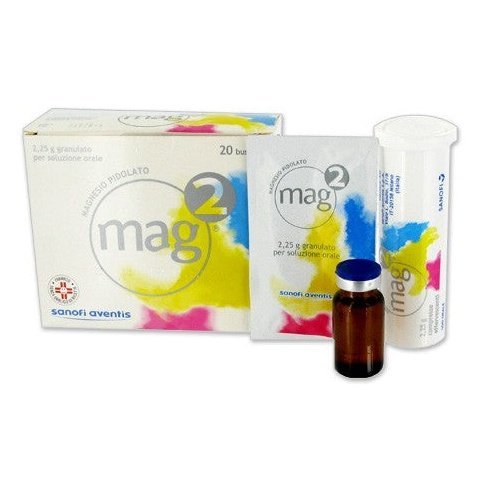
Mag 2 Orosolubile is a magnesium -based food supplement formulated to combat magnesium deficiency states that can manifest themselves with tiredness, fatigue, muscle cramps or irritability. Magnesium is an essential mineral for the correct functioning of muscles, the nervous system and to reduce the feeling of tiredness and fatigue. The orosoluble sachets of Mag 2 offer a practical and fast method of intake, without the need for water.
ACTIVE INGREDIENTS
Active ingredients contained in Mag 2 Orosolubile 20 Sachets 2.25 g - What is the active ingredient in Mag 2 Orosolubile 20 Sachets 2.25 g?
One vial of oral solution contains, active ingredient: 1,500 g of magnesium pidolate (corresponding to 122 mg of Mg^++ ion). Excipients with known effects: sucrose, sodium methyl parahydroxybenzoate E219, sodium propyl parahydroxybenzoate E217, ethanol (contained in the orange flavour excipient). One single-dose sachet of oral solution contains, active ingredient: 1,500 g of magnesium pidolate (corresponding to 122 mg of Mg^++ ion). Excipients with known effects: sucrose, sodium methyl parahydroxybenzoate E219, sodium propyl parahydroxybenzoate E217, ethanol (contained in the orange flavour excipient). One sachet of powder for oral solution contains, active ingredient: 2,250 g of magnesium pidolate (corresponding to 184 mg of Mg^++ ion). Excipients with known effect: sucrose. For the full list of excipients, see section 6.1.
EXCIPIENTS
Composition of Mag 2 Orosolubile 20 Sachets 2.25 g - What does Mag 2 Orosolubile 20 Sachets 2.25 g contain?
Mag2 1.5 g/10 ml oral solution: sucrose, orange flavouring (containing ethanol), sodium methyl parahydroxybenzoate E 219, sodium propyl parahydroxybenzoate E217, purified water. Mag2 2.25 g powder for oral solution: sodium saccharin, citric acid monohydrate, sucrose, lemon flavouring.
DIRECTIONS
Therapeutic indications Mag 2 Orosolubile 20 Sachets 2.25 g - Why is Mag 2 Orosolubile 20 Sachets 2.25 g used? What is it for?
Magnesium deficiency states.
CONTRAINDICATIONS - SIDE EFFECTS
Contraindications Mag 2 Orosolubile 20 Sachets 2.25 g - When should Mag 2 Orosolubile 20 Sachets 2.25 g not be used?
Hypersensitivity to the active substance or to any of the excipients listed in paragraph 6.1; severe renal insufficiency (creatinine clearance less than 30 mL/min); not to be administered to subjects undergoing digitalis therapy.
DOSAGE
Quantity and method of taking Mag 2 Orosolubile 20 Sachets 2.25 g - How do you take Mag 2 Orosolubile 20 Sachets 2.25 g?
Dosage, for adults only: 3 vials or 3 single-dose sachets of solution or 2 sachets of powder per day. Paediatric population: in children, the dosage may be established by a previously consulted doctor. Caution: use only for short periods of treatment. Instructions for use, Mag2 1.5 g/10 ml oral solution: it is advisable to shake before use. To open the vial, twist the top and detach it. Take the contents of the vial as is or dilute it in water. Mag2 2.25 g powder for oral solution: dissolve the contents of one sachet in water.
CONSERVATION
Storage Mag 2 Orosolubile 20 Sachets 2.25 g - How do you store Mag 2 Orosolubile 20 Sachets 2.25 g?
Oral solution: Store below 25 degrees C. Powder for oral solution: This medicine does not require any special storage conditions.
WARNINGS
Warnings Mag 2 Orosolubile 20 Sachets 2.25 g - About Mag 2 Orosolubile 20 Sachets 2.25 g it is important to know that:
In case of concomitant calcium deficiency, magnesium deficiency should be corrected before administering supplemental calcium. In patients with moderate renal insufficiency, it is necessary to reduce the dosage and monitor renal function and magnesium levels, due to the risk associated with hypermagnesemia. It is advisable to consider the possibility that cardiovascular depression may occur during treatment. MAG2 oral solution contains sucrose: patients with rare hereditary problems of fructose intolerance, glucose-galactose malabsorption or sucrase-isomaltase insufficiency should not take this medicine. Parahydroxybenzoates (sodium methyl parahydroxybenzoate E219 and sodium propyl parahydroxybenzoate E217): may cause allergic reactions (possibly delayed); sodium: this medicine contains less than 1 mmol sodium (23 mg) per vial or sachet, i.e. essentially "sodium-free"; ethanol: This medicine contains 18 mg of alcohol (ethanol) in each vial or sachet, which is equivalent to 1.8 mg/ml. The amount in each dose of this medicine is equivalent to less than 0.2 ml of wine or 0.5 ml of beer. The small amount of alcohol in this medicine will not produce any relevant effects. MAG2 powder for oral solution contains sucrose: Patients with rare hereditary problems of fructose intolerance, glucose-galactose malabsorption or sucrase-isomaltase insufficiency should not take this medicine. Sodium: This medicine contains less than 1 mmol (23 mg) per dose, that is to say essentially 'sodium-free'.
INTERACTIONS
Interactions Mag 2 Orosolubile 20 Sachets 2.25 g - Which medicines or foods can modify the effect of Mag 2 Orosolubile 20 Sachets 2.25 g?'
In case of concomitant treatment with oral tetracyclines, the administration of MAG2 should be delayed by at least 3 hours. Quinolones should be administered at least 2 hours before or 6 hours after the administration of magnesium-containing products to avoid interference with their absorption. The concomitant administration of magnesium-containing products and cholecalciferol (vitamin D3) may lead to the onset of hypercalcemia. The concomitant use of preparations containing calcium or phosphate salts is not recommended because these products prevent intestinal absorption of magnesium. The simultaneous intake of magnesium-containing products with drugs that depress the Central Nervous System may potentiate the effects of magnesium on the CNS and should be carefully evaluated.
SIDE EFFECTS
Like all medicines, Mag 2 Orosolubile 20 Sachets 2.25 g can cause side effects - What are the side effects of Mag 2 Orosolubile 20 Sachets 2.25 g?
The following convention has been used for the classification of undesirable effects: very common >= 1/10; common >= 1/100 and < 1/10; uncommon >= 1/1,000 and < 1/100; rare >= 1/10,000 and < 1/1,000); very rare < 1/10,000 and not known (frequency cannot be estimated from the available data). Gastrointestinal disorders. Frequency Not known: gastrointestinal disorders, diarrhoea, abdominal pain. Skin and subcutaneous tissue disorders. Frequency not known: skin reactions. Immune system disorders. Frequency not known: hypersensitivity. Exceptional cases of individual intolerance to magnesium have been reported, which can be treated with oral or parenteral antihistamines. Reporting of suspected adverse reactions. Reporting of suspected adverse reactions that occur after authorisation of the medicinal product is important. It allows continued monitoring of the benefit/risk balance of the medicinal product. Healthcare professionals are asked to report any suspected adverse reactions via the national reporting system at https://www.aifa.gov.it/content/segnalazioni-reazioni-avverse.
PREGNANCY AND BREASTFEEDING
If you are pregnant or breast-feeding, think you may be pregnant or are planning to have a baby, ask your doctor for advice before taking Mag 2 Orosolubile 20 Sachets 2.25 g
There are limited data on the use of MAG2 in pregnant women. However, no conclusions can be drawn as to whether the use of MAG2 is safe during pregnancy. MAG2 can be used during pregnancy only if the potential benefits to the mother outweigh the potential risks, including those to the fetus. Magnesium is considered compatible with breastfeeding.

























